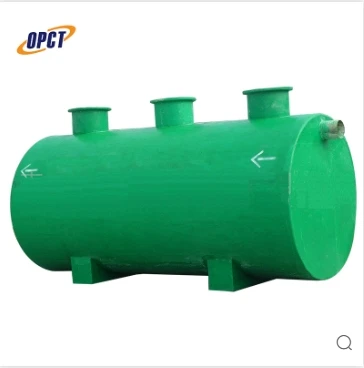FRP (Fiber Reinforced Plastic) septic tanks are revolutionizing waste management solutions due to their lightweight, durable, and corrosion-resistant nature. Traditionally, septic tanks have been constructed with concrete or steel, materials that, while sturdy, present significant drawbacks in terms of weight, susceptibility to corrosion, and installation complications. FRP septic tanks address these issues and offer numerous advantages, making them a remarkably practical choice for residential, commercial, and industrial applications.

One notable advantage of FRP septic tanks is their lightweight nature. Unlike their concrete counterparts, which require heavy machinery for relocation and installation, FRP tanks can often be handled manually or with light machinery, reducing labor and transportation costs significantly. This quality not only decreases overall project expenses but also speeds up the installation process, making FRP tanks a time-efficient solution. Furthermore, in areas with limited access, where heavy machinery might not operate efficiently, FRP septic tanks offer a viable alternative.
Durability and corrosion resistance are crucial metrics where FRP septic tanks truly shine. Constructed from a composite of high-strength glass fibers embedded in a resin matrix, these tanks exhibit exceptional structural integrity. This construction method renders them immune to rust, a common issue with metal tanks, and degradation from acidic soil and wastewater, which often plagues concrete tanks. This longevity translates to a longer lifespan for the tank, ensuring that property owners derive maximum value from their investment.

In addition to durability, the non-porous nature of the resin in FRP tanks prevents leakage, ensuring that the containment of waste does not affect the surrounding soil and groundwater. This factor promotes environmental sustainability and aligns with increasing regulations and standards for waste management practices globally. For environmentally conscious consumers and businesses, the promise of reduced environmental footprints is a compelling reason to consider FRP septic tanks.
From an engineering perspective, FRP septic tanks offer immense flexibility in terms of customization. Manufacturers can easily alter the dimensions, capacity, and shape of these tanks to meet specific requirements, catering to a diverse range of applications. This adaptability extends to the integration of additional features such as reinforced ribs for added strength, connections for advanced filtration systems, and the incorporation of monitoring technologies. This customizability ensures that FRP tanks meet precise operational needs without compromising on efficiency or reliability.
frp septic tank
The ease of maintenance associated with FRP tanks should not be overlooked. As these tanks are less susceptible to the growth of algae, fungi, and bacteria—problems exacerbated by the porosity and chemical reactions affecting traditional materials—cleaning and maintenance routines are simplified. This ease of maintenance reduces the overall cost of ownership and minimizes the risk of system failures due to structural degradation or leakage over time.
Moreover, the manufacturing process of FRP tanks is relatively low-impact compared to that of concrete or steel tanks. Using less energy and resources, FRP tanks boast a lower carbon footprint from production through to installation. This eco-friendly aspect not only supports global sustainability goals but also aligns with the growing consumer demand for green and responsible products.
It’s important to source FRP septic tanks from reputable and certified manufacturers who adhere to industry standards. This assurance of quality and consistency underpins the trustworthiness and performance of the tank under field conditions. Users should seek out tanks that comply with local health and safety guidelines, as well as environmental regulations, to ensure both safety and efficacy.
In conclusion, the innovative features and benefits of FRP septic tanks—ranging from their lightweight and corrosion-resistant properties to their environmental and economic advantages—make them a superior choice in waste management solutions. Whether utilized in new constructions or retrofitting projects, FRP technology is setting new benchmarks for reliability, efficiency, and sustainability, redefining the standards for modern septic systems worldwide.




